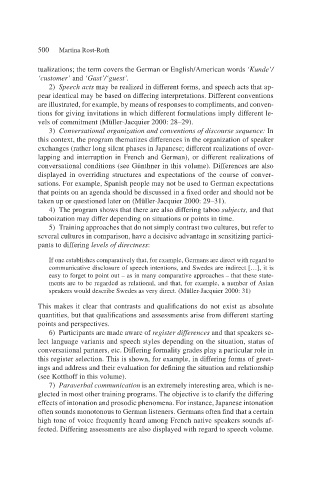Page 522 - Handbooks of Applied Linguistics Communication Competence Language and Communication Problems Practical Solutions
P. 522
500 Martina Rost-Roth
tualizations; the term covers the German or English/American words ‘Kunde’/
‘customer’ and ‘Gast’/‘guest’.
2) Speech acts may be realized in different forms, and speech acts that ap-
pear identical may be based on differing interpretations. Different conventions
are illustrated, for example, by means of responses to compliments, and conven-
tions for giving invitations in which different formulations imply different le-
vels of commitment (Müller-Jacquier 2000: 28–29).
3) Conversational organization and conventions of discourse sequence: In
this context, the program thematizes differences in the organization of speaker
exchanges (rather long silent phases in Japanese; different realizations of over-
lapping and interruption in French and German), or different realizations of
conversational conditions (see Günthner in this volume). Differences are also
displayed in overriding structures and expectations of the course of conver-
sations. For example, Spanish people may not be used to German expectations
that points on an agenda should be discussed in a fixed order and should not be
taken up or questioned later on (Müller-Jacquier 2000: 29–31).
4) The program shows that there are also differing taboo subjects, and that
tabooization may differ depending on situations or points in time.
5) Training approaches that do not simply contrast two cultures, but refer to
several cultures in comparison, have a decisive advantage in sensitizing partici-
pants to differing levels of directness:
If one establishes comparatively that, for example, Germans are direct with regard to
communicative disclosure of speech intentions, and Swedes are indirect […], it is
easy to forget to point out – as in many comparative approaches – that these state-
ments are to be regarded as relational, and that, for example, a number of Asian
speakers would describe Swedes as very direct. (Müller-Jacquier 2000: 31)
This makes it clear that contrasts and qualifications do not exist as absolute
quantities, but that qualifications and assessments arise from different starting
points and perspectives.
6) Participants are made aware of register differences and that speakers se-
lect language variants and speech styles depending on the situation, status of
conversational partners, etc. Differing formality grades play a particular role in
this register selection. This is shown, for example, in differing forms of greet-
ings and address and their evaluation for defining the situation and relationship
(see Kotthoff in this volume).
7) Paraverbal communication is an extremely interesting area, which is ne-
glected in most other training programs. The objective is to clarify the differing
effects of intonation and prosodic phenomena. For instance, Japanese intonation
often sounds monotonous to German listeners. Germans often find that a certain
high tone of voice frequently heard among French native speakers sounds af-
fected. Differing assessments are also displayed with regard to speech volume.

